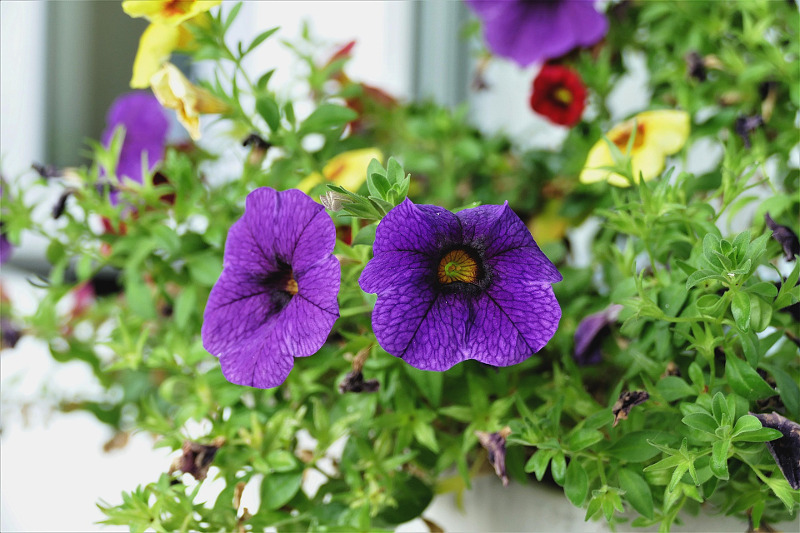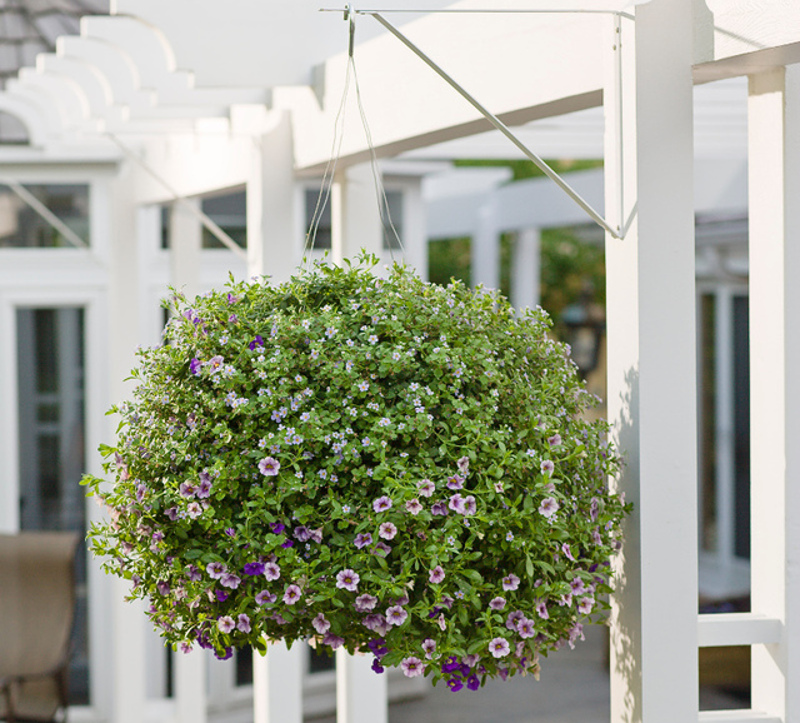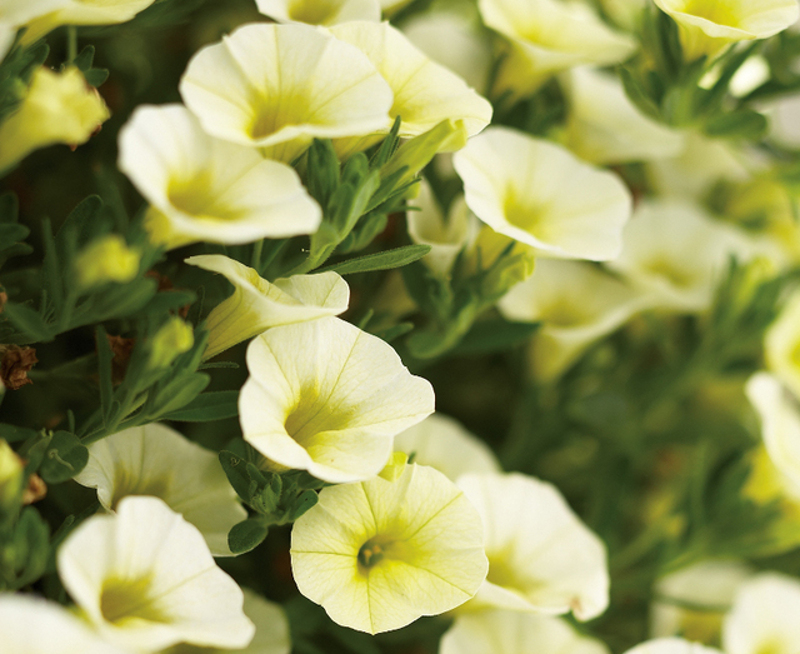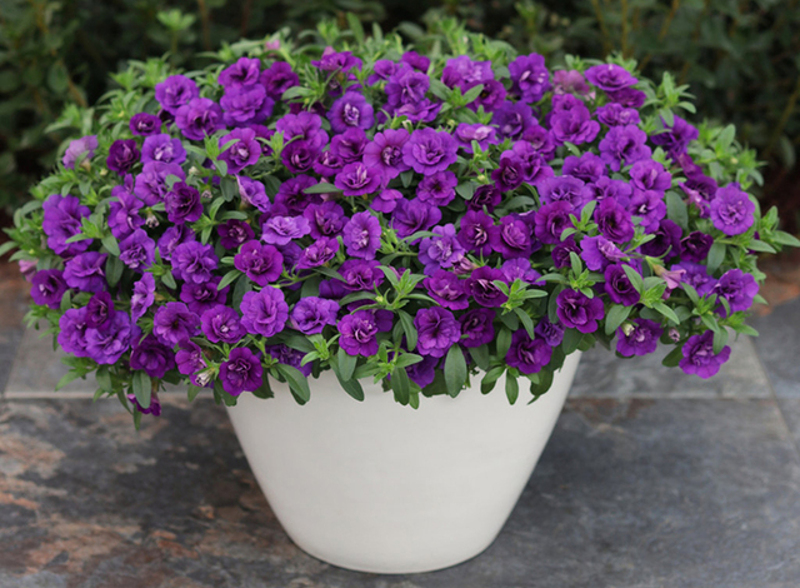Fast-tracking to beat petunias in popularity for container plants, Calibrachoa are tender perennial flowering powerhouses that resemble a “million bells” of tiny petunias. There are 28 different species. The Royal Horticultural Society actually classifies them as a type of petunia rather than an independent genus. Introduced in the 1900s, Calibrachoa are trailing plants that attract pollinators including hummingbirds. They range from one to two feet tall and wide. They are hardy to USDA zones 9-11.

Planting Calibrachoa
Calibrachoa plants prefer full sun, but can also thrive in partial shade with fewer but longer-lasting flowers. They are ideal container plants, since they love excellent drainage. They can be grown in the ground, but it’s more challenging to offer them the drainage they need.
The ideal potting medium is moist but well-drained, organically rich soil, with a pH of 5-6.5. They can take some drought once established. Mulch to keep the roots cool. Because of their tenderness, wait to plant outside when temperatures are over 55 degrees F.
Watering Calibrachoa
Calibrachoa like even moisture, but to almost dry out between waterings. It’s helpful to make sure your soil is well-drained and, if using a container, that it has good drainage. Calibrachoa that are overwatered are prone to root rot. Let the soil dry to two inches, then water deeply. They like humidity as well, so partial shade can be helpful in windy or dry areas.

Fertilizing Calibrachoa
Calibrachoas love fertilizer. At planting, start with a slow-release fertilizer. Give the plant a diluted liquid fertilizer every couple of weeks throughout the season. Make sure to follow the directions on the fertilizer. If your leaves are turning yellow, the plant may need fertilizer, or possibly more sun. If leaves are yellowing despite consistent fertilizing, the pH may be too high or low.
You can amend this with an application of iron chelate (sprays are absorbed faster than granular treatments) which should green up your plant’s leaves again quickly. You can amend this with an application of iron chelate (sprays are absorbed faster than granular treatments) which should green up your leaves quickly.
Pruning Calibrachoas
Deadheading calibrachoas is not required. It’s their superpower. They are called self-cleaning, meaning the spent flowers drop on their own, making them much easier than petunias to care for. They do benefit from pinching back if they become leggy. This can be done any time during the growing season. It’s useful to add some liquid fertilizer at this time.

Caring For Calibrachoa in Pots
Choose a spot in full to partial sun. They like humidity as well, so partial shade can be helpful in windy or dry areas. Calibrachoa like even moisture, but to almost dry out between waterings.
You’ll want to check that the soil is dry to approximately two inches deep before watering deeply. Overwatering can encourage root rot. Fertilize with a balanced fertilizer at planting and follow with a liquid fertilizer every two weeks to ensure optimal performance.

Winter Care for Calibrachoa
In zones 9-11 where Calibrachoa are hardy, apply mulch to add warmth to the roots. They dislike being overly wet. If the area gets cooler than about 65 degrees F, stop fertilizing and water less often than during the growing season.
If in the very warmest parts of its hardiness range, continue watering and fertilizing, but know you may need to replace plants more often. If the region gets significant winter rain, move the pot to a protected area under an eave of the roof. In areas cooler than zone 8, consider them an annual.
Common Calibrachoa Care Questions
Do Calibrachoa Attract Pollinators?
Calibrachoa attracts hummingbirds, bees, and many other helpful insects including butterflies!
Do Calibrachoa Spread?
Calibrachoa is a hybrid plant/flower and do not produce seeds.
Does Calibrachoa Come Back Every Year?
Calibrachoa is grown as annuals in most USDA Hardiness Zones, but can be grown as perennials in zones 9-11.
Why Do Calibrachoa Leaves Turn Brown?
Calibrachoa leaves can turn brown from under- or over-watering, or too much fertilizer. Water them when the top 1 or 2 inches of soil is dry and that your soil is well-draining to help prevent root rot.
What Is The Growth Rate Of Calibrachoa?
Calibrachoa, also known as Million Bells, are fast growers, and the spiller quickly reaches towards the ground, attracting butterflies and hummingbirds, too!
Have a question about Calibrachoa? Fill out the form below and we will try and get back to your question as soon as possible. We may even feature your question on this article to help other gardeners!
 |
Author Erica Browne Grivas - Published 07-22-2021 |
